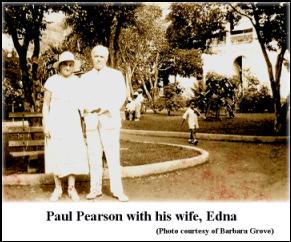Governor Pearson and Affordable Housing
The U.S. Virgin Islands’ first civilian Governor, Paul M. Pearson, served from 1931 to 1935. A Quaker college educator from Philadelphia who had organized and managed the traveling Swarthmore Chautauqua, Governor Pearson initiated a number of programs that were intended to improve the depressed economy of the territory and the cultural life of its citizens. In addition to building the first tourist hotel in the territory, establishing an export market for local crafts, revitalizing the sugar industry, and creating a rum company (to the chagrin of his Quaker friends in Philadelphia), Governor Pearson inspired the territory’s first “affordable housing” effort. (Such projects used to be called “public” or “low income” housing, which terms presumably were abandoned because they came to have a pejorative connotation.) Governor Pearson described the housing project in a letter written in October 1933:

“Jim Tilly, our Commissioner of Public Works, has designed a half dozen variations of a two-room house, which will be built for the poorer people, beginning with homesteaders. This is one of the most important things that has happened to the Virgin Islands during my Administration. We have $45,000 available, the houses will cost about $500 each, and will be sold on two-year payments. That will make the payments about $3.50 per month, which includes_minified the payment on principal and 4% interest. At the end of the period, the person will own the house. Each house is to have sufficient space for a kitchen garden. The half dozen variations in the plan will prevent the appearance of barracks. Besides the two rooms, there is an outside kitchen, which has only a roof as most cooking by the poorer people is done out of doors. Each house has a gallery and underneath it a concrete cistern of about 1200 gallons’ capacity, and each lot will be provided with a privy. The cistern and the privy may not seem to you very important in such a plan, but I assure you that both are indispensable. Many of the poorer people carry their water long distances, others use a rain barrel, while a few have two or three rain barrels, and they are considered opulent.”
After leaving office in 1935 Governor Pearson was placed in charge of the then very new national government housing program. (He was Assistant Director of Housing in the Interior Department.) He pioneered the first public housing units in such difficult cities as Charleston, South Carolina, Chicago and San Francisco, and he paved the way for integrated housing in northern cities. He was even able to secure passage of a new housing law in California, a state that had banned public housing. In light of these efforts, it was appropriate that the U. S. Virgin Islands name one of its first public housing developments – Paul M. Pearson Gardens in Charlotte Amalie – for Governor Pearson. He died in March 1938. On his death The New York Times observed that as Governor his “… crowning achievement was that of setting out upon a twenty-year plan for the welfare of a few thousand people in a few little islands of the Antilles, somewhere in the supposed vicinity of the Lost Atlantis. He got hardly beyond the first year or two, however, with his utopian experiment before he had to give it over into other hands.”
(Barbara Pearson Fogg Grove is a SJHS member, part-time resident of Calabash Boom, St. John, and the granddaughter of Gov. Paul M. (Milton) Pearson.)
Editor’s note: Paul M. Pearson (1871-1938) was a noted Quaker educator, editor, and speaker, a professor of public speaking at Swarthmore College, the first civilian governor of the U.S. Virgin Islands, an assistant director of the U.S. Housing Authority, and a leading founder and executive in the Chautauqua movement. The low income housing discussed in this article, was in fact, a part of Governor Pearson’s “Homesteading project” a federally funded program whereby the VI government would acquire large plots of unused land, then subdivide the property and offer them under favorable terms to Virgin Islanders. In 1940, the then Councilman Julius Sprauve, initiated a similar process on St. John, which successfully culminated in land in Estate Contant and Enighed being acquired by the municipal government, and being parceled out to Virgin Islanders at reasonable and affordable rates.
[Dr. Paul Pearson]
